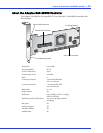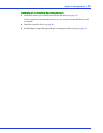
Chapter 4: Getting Started ● 20
Choosing a RAID Level
This section provides a brief overview of the RAID levels supported by your HostRAID
controller, including the minimum and maximum number of disk drives required by each.
RAID 0 (Non-redundant Array)—Stripes data across multiple disk drives. Improved
performance but no redundancy (see page 60).
RAID 1 Array—Created from two disk drives where one disk drive is a mirror of the other (the
same data is stored on each disk drive). Redundancy, but reduced capacity (see page 61).
RAID 10 Array—Built from two or more equal-sized RAID 1 arrays, stripes and mirrors data
across multiple disk drives. Redundancy and improved performance (see page 61).
Use the table on page 60 to see how many disk drives you must connect to your HostRAID
controller to support the RAID level you want.
Selecting Disk Drives
When selecting disk drives for your RAID array, ensure that all the disk drives have the same
performance level. You can use different-sized disk drives in the array, but the array will be
limited to the capacity of the smallest and slowest disk drive.
For more information, refer to the Adaptec Storage Manager User’s Guide or Adaptec Storage
Manager online Help.
Disk Drives for Your Controller
Your SAS controller supports both SAS and SATA (Serial ATA) disk drives. For cable
information, see next section.
Selecting Cables
This section describes the cable options and requirements for your HostRAID controller.
SAS Cables
You need one SAS cable for each disk drive you are connecting to your HostRAID controller.


















